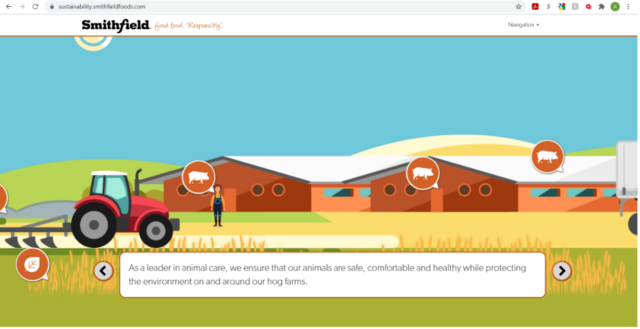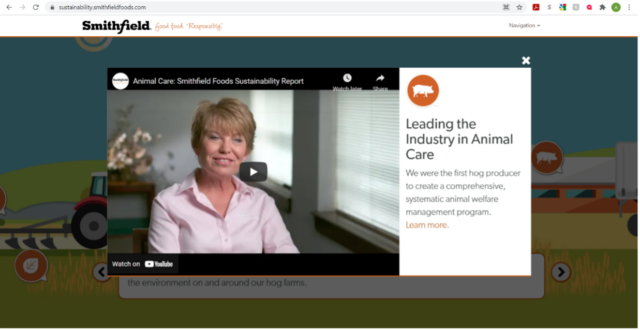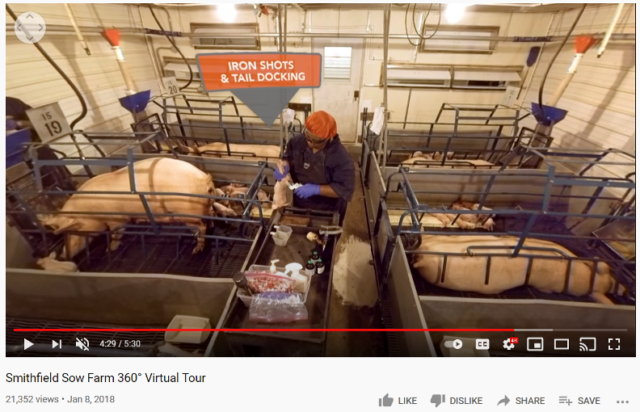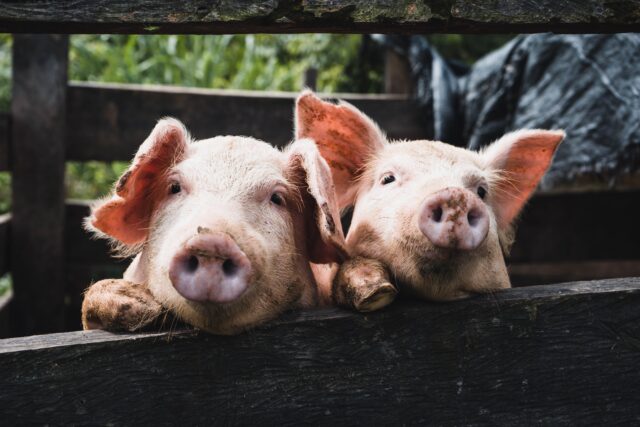“Animals did not ask us, as humans, to make laws that apply to them. Nor did we ask if they wanted our laws. . . . We use law to put animals into categories of our own choosing and to control them, both conceptually and physically. We use law not to recognize, embrace, cultivate, and enable their own innate characteristics and abilities but rather to position them in a way that is convenient and conducive to our wants and needs.”
- Kristen Stilt, Harvard Law School1
“[I]t is the economic forces that drive pork producers to do things that hurt or stress their pigs.”
- John J. McGlone, Pork Industry Institute2
Part I: The Problem
Lauri
Lauri tried to sleep as the manure coating the floor mixed with the already-infected lesions on her face. But that otherwise-typical April night would soon take a turn as shadowy figures moved in around her. She found herself quickly surrounded by animals of a species that made her freeze with fear. Only later would it become apparent that her fear was misplaced: those animals were humans from an animal-rights group rescuing her from slaughter. Lauri was a pig on a Smithfield Foods farm.3
While different people will have different reactions to that story, many will surely heave a sigh of relief upon learning that the victim is a mere pig, as though that reduces the horror of Lauri’s situation. “At least she is not human!” But why does withholding her species induce more sympathy? Why, indeed, must this assignment require a humanizing account in order to connect to readers?
This typical reaction stems from a basic presumption that nonhuman animals—especially those raised for food—are much less worthy of our concern. And if any doubt remains as to where the law’s priorities lie, note that the only legal actions that arose from Lauri’s rescue were criminal prosecutions against two of the rescuers.4
Pigs in Agriculture
The conditions Lauri endured were hardly unique. Especially as American hog-farming companies have grown larger and more confined, routine welfare issues for farmed pigs include severe overcrowding, barren environments that thwart pigs’ natural exploratory drives, bare flooring that makes sleeping and walking difficult, poor air quality, filth, and routine inhumane handling (or, less euphemistically, abuse).5 Famously, yet still routinely, hog farms often confine pregnant sows to gestation crates, and nursing sows to farrowing crates, that are so narrow they cannot even turn around for weeks or months at a time.6 And piglets often endure castration, tooth clipping with wire cutters, ear notching, and tail docking—all with no pain relief.7
And Lauri is far from alone. Had she not been rescued, she would have been one of 132 million pigs killed in the United States every year in animal agriculture.8 For a sense of scale, that is more than the combined populations of the world’s five most populous metropolitan areas: Tokyo, Delhi, Shanghai, Sao Paulo, and Mumbai.9 And that national figure represents less than one tenth of the 1.35 billion pigs slaughtered for meat worldwide in the fairly typical pork-producing year of 201910—well over the entire population of Sub-Saharan Africa, or more than double the total population of Latin America and the Caribbean.11 Humans are scarcely able to comprehend numbers at this scale.
Smithfield
Smithfield Foods Inc., or Smithfield, is that huge industry’s largest player, having “produced” (killed) 21.7 million market hogs in 2019.12 It is a subsidiary of WH Group Limited, a multinational company headquartered in Hong Kong and incorporated in the Cayman Islands.13 But Smithfield itself is headquartered and incorporated in Virginia.14 From its perch atop the pork industry, Smithfield provides an excellent lens through which to view how corporations exercise power to reassure customers that eating pigs is acceptable, even desirable.
In Part 2, this Paper shows how Smithfield uses its power to promulgate narratives that hide pigs, frame brutal practices as wholesome and even animal friendly, and portray documented abuses as an endless chain of one-off slip-ups. These self-motivated pitches entrench psychological phenomena called carnism and speciesism that legitimate keeping animals outside our circles of justice and toward the bottom of the literal and figurative societal food chains. Part 2 also briefly sketches possible solutions that could help interrupt these narratives.
But this Paper does not seek to portray Smithfield merely as a dispositionally malevolent actor. Rather, Part 3 explains the forces acting on the company to shape how it wields its influence, especially corporate law. Specifically, it shows that corporate law promotes a focus on economic markets and defines concepts like success, vulnerability, and liability in financial terms. That monetary focus removes just about any chance that nonhuman animals—who exist outside almost all economists’ conceptions of markets—ever had of being taken seriously by corporate decisionmakers. It both reflects and reinforces the law’s conception of animals as property.
The Conclusion notes that these kinds of speciesist, carnist forces act in at least two ways. They make omnivores more comfortable with their diets’ impacts on animals, and they make Smithfield employees, managers, shareholders, and directors more comfortable with creating those impacts in the first place. Hundreds of millions of pigs’ wellbeing depends on resisting these forces.
Part II: The Narratives
Mind Sciences
A moment’s thought suggests the oddness of humans’ ability both to like animals generally and to eat many of them who were raised in horrid conditions. The dissonance this conflict creates cries for resolution—and, given how comfortable most people are eating even highly intelligent pigs, our minds readily supply it. In her seminal book Why We Love Dogs, Eat Pigs, and Wear Cows, psychologist Melanie Joy coined a term for the cognitive processes supplying that comfort: “carnism.” In short, carnism creates schemas that help us “change our perception of our [carnivorous] behaviors so that they appear to match our values.”15 The resulting structures leave us psychologically numb to the violence animals suffer at the hands of industrial agricultural companies like Smithfield.16 And that numbing renders the system performing that violence largely invisible, allowing us to avoid and deny its existence.17 Consider a study finding that Danish families preferred minced meat to whole pieces in part because “minced meat was not associated with any living animal.”18 And consider how gross many find eating food with eyes—which, of course, all farmed animals had.
[I]n a “single life raft” situation, how many humans would rescue, say, a pig or chicken over, say, a dog or bald eagle (never mind another human)?
Closely related to carnism is the philosophical and psychological concept of speciesism—the phenomenon of “assign[ing] moral worth to individuals on the basis of species membership.”19 According to leading researchers on the topic, “[s]peciesism manifests itself in two key ways”: (i) valuing humans over other animals; and (ii) valuing some animals, like dogs or megafauna (orcas, pandas, elephants, and the like), over others.20 Hence why conservation groups foreground polar bears rather than walruses when raising money, even though both are highly intelligent and face strikingly similar threats from climate change. And in a “single life raft” situation, how many humans would rescue, say, a pig or chicken over, say, a dog or bald eagle (never mind another human)?
These two psychological phenomena—carnism and speciesism—underlie people’s comfort with the well-documented pain and suffering that animals raised for meat so often experience. They enable humans to use schemas that categorize animals as “other,” “undeserving,” and even “food.”21 Those categories impact how we perceive these animals enormously. For instance, one study presented participants with an unfamiliar animal species, provided mostly identical information about the species, but told only some of them that the animal was used as food in some cultures. That “food” categorization alone was enough to cause people to “attribute[] it significantly less capacity to suffer,” thereby yielding “diminished moral concern.”22 Consider how much more we are willing to do to animals with (supposedly) less suffering capacity and how easily even “nice” people can rationalize inflicting shock-box-style pain on them. And once established, these schemas can quickly grow entrenched.23
Like all schemas, these ones are not simply some natural, inevitable fact of the world but are constructed.24 And that construction is not random but reflects the ability of a dominant group—humans, and especially humans and their corporations who profit from them—to exert power in ways that shape them, and the categories they suggest, to those groups’ benefit.25 Put differently, these profiteers do not just passively receive exogenous schemas but rather actively, and motivatedly, help design them. These schemas are, in a nontrivial sense, their schemas.
Smithfield as Schema Shaper
Whether deliberately or subconsciously, Smithfield works hard at contributing to a number of schemas that keep its most unsavory practices hidden or, worse, render them “savory.” Take, for instance, tweets from Smithfield’s public-facing Twitter account. A typical perusal in March 2021 included a reminder that even the Spring Equinox includes ample “#TimeForBacon,”26 a spirited Valentine’s Day request to “write a poem to meat” (and to one’s favorite particular meats),27 and Groundhog Day-inspired grumblings about a mere “6 more weeks of bacon sound[ing] a little short.”28
Perhaps unsurprisingly, absent from any of these advertisements is a single picture, hashtag, or even mention of (live) pigs. The world Smithfield portrays thus hides these suffering beings. As with shock-box “learners” who the “teacher” cannot see, we thereby perceive less injustice when we contribute to their suffering. Within this construction, Lauri and her companions do not exist; only bacon and pork chops do. There are no animals, only food.
And for those motivated to look deeper, Smithfield is all too happy to reassure that Lauri’s treatment is, despite our common-sense intuitions, world class. Take their interactive website called “Sustainable from Farm to Fork,” which lets users scroll through Smithfield products’ cartoonish journey from smiling farmers to production and distribution facilities to grocery stores to your family’s home. Along the way, banners proudly proclaim the company’s leadership in areas like “animal care.”

Figure 1: “Sustainable from Farm to Fork” Website (Source: Smithfield Foods).
The journey includes clickable icons that uncover more about the company’s supposed leadership in animal care, environmental stewardship, and more. Once again, the pig-silhouette icons are the cartoons’ only suggestion of the lives that ended in this process.

Figure 2: A Video and More Self-Accolades Shown After Clicking a Pig Icon (Source: Smithfield Foods).
Thus, Smithfield shows users only cartoonish silhouettes of pigs, and then, only to suggest how great a life its animals lead. The boredom, squalor, festering wounds, self-mutilation, and abuse that undercover investigations routinely uncover in Smithfield facilities29 simply do not exist. Only “safe[ty],” “comfort[],” and “health[]” do.
Hiding pigs’ suffering in these ways contributes to the othering, out-grouping dynamics of the dominant “pigs-as-food” schema. When people enjoy bacon—as has become something of a corporate-driven cultural must30—the last thing many want to remember is the life or the mind that had to suffer and die for it. Recall Danes’ preference for non-animal-like minced meat and many people’s general distaste for food with eyes. Denying pigs’ experiences and thinking only of the food helps maintain meat eating’s popular legitimacy.31 And Smithfield’s dominance of the pork industry, and its place in many Americans’ refrigerators, gives them the resources and stature it needs to legitimate these narratives.32
But to say that Smithfield simply hides its brutal practices would be overly simple. For those curious enough to investigate even further, the company presents horrid practices as though they are normal and problem free. Take, for instance, an interactive, 360-degree YouTube video Smithfield posted openly showing its sows in crates so small they cannot turn around and its workers cutting off piglets’ tails with no pain relief.

Figure 3: A Video Showing Cramped Sows and Analgesic-Free Tail Docking (Source: Smithfield Foods via YouTube).
What Smithfield does, then, is in many ways more sinister than erasing suffering animals: it shows animals being abused and mistreated. That openness normalizes the mistreatment and dulls people’s reactions to it. If it were so bad, viewers naturally think, why would they be so open about it?
Don’t worry, Smithfield’s openness reassures. [Lauri] is just fine. This is normal.
In an important sense, then, Smithfield does not shape a schema without salient pigs; it shapes a schema without salient suffering pigs. It shows its pigs in situations that are hard to deny as brutal—how could miniscule cages and pain-relief-free tail docking be otherwise?—as though to suggest that such is normal, okay, and nothing to worry about. The company encourages us to take comfort in its openness: how could it show these conditions if pigs really were suffering? Once omnivores find that comforting resolution, they lose much of a reason or motivation to reintroduce the dissonance of stepping outside it. The resulting schemas encouraging pork eating entail some dim but dubious denial that any animal suffered for one’s meals. And these sort of schemas lead people to dismiss stories about Lauri—to deny that her blood-stained face, evidence of infection, and fact that she was destined for a slaughterhouse mean anything. Don’t worry, Smithfield’s openness reassures. She is just fine. This is normal.
Solutions
Thus, we have an idea that Smithfield’s preferred narratives help ease the dissonance that animal-liking humans feel when eating pork. Solutions should therefore center on—in addition to helping farmed pigs directly—reintroducing some of that dissonance. Of course, fully or even adequately discussing any of these solutions would take up far more space than is available within this Paper’s scope. But for illustrative purposes, and to stimulate some thinking on the topic, the Paper presents a brief list of possible interventions.
These interventions include, ordered roughly from least to most radical:
- Investing in alternative-protein for-profit corporations, like Beyond or Impossible, or in cell-based meat companies, to make vegetarianism easier;
- Non-coercively incentivizing farmers to treat animals better;
- Mandating disclosure of farming practices in governmental filings, with monitoring mechanisms;
- Investing in alternative-protein nonprofits to achieve the same as above without cementing corporate power as much;
- Bolstering the pro-animal side of people’s ethical ledgers; for example, mandating that labels disclose meat’s negative externalities and harms, as on cigarette or prescription-drug labels;
- According animals legal personhood to increase legal accountability;
- Providing animals with formal governmental representation;
- Providing animals with representation in private corporate decisions (e.g., on the board or at shareholder meetings);
- Totally banning farming animals in especially harmful ways; or
- Totally banning farming animals altogether.
How to choose from these options is a complex question, again deserving more attention than is possible within this Paper’s constraints. But, at a general level, activists should bear in mind that few of these options are mutually exclusive. Indeed, progress along some dimensions may make progress easier along others. For instance, investing in alternative proteins (e.g., plant-based burgers) to displace meat in people’s diets may initially appear only to scratch the problem’s surface. “Real” meat would still enjoy enormous demand. But, insofar as people eat less meat, they may plausibly experience less dissonance from, and thus may be more open to, arguments for more radical changes. They would have fewer animal-harming behaviors to have to reconcile. Put differently, many people’s scope of justice may expand, and carnist or speciesist ideation might decrease, making even more progress possible. A multi-pronged approach, borrowing from many of these ideas, is therefore likely to be most impactful.
Granted, few if any of these ideas are likely to come easily. Humans’ domination of other animals has been entrenched for centuries. But most people—including anyone who loves their pet or appreciates their backyard birds—already place at least some animals within their circles of justice. The disgust people feel when faced with the prospect of eating their beloved dog or visiting cardinal surely bodes well for the prospects of extending similar compassion to other species. And the sheer magnitude of suffering on farms, and of the number of animals enduring those conditions, make inaction intolerable.
Part III: Corporate Law's Role
A Fiscal Focus
At this point, an easy response would be to frame Smithfield as a group of bad people who created a bad company to do bad things—making all of the above solutions, or really any meaningful progress for suffering pigs, more difficult. That one-dimensional, dispositionist story is too simple. Smithfield is, like just about all human-derived entities, shaped by situational forces, just as its customers are shaped by the schemas it helps perpetuate. Among the most important of these forces acting on corporations and corporate actors is corporate law.
Perhaps the deepest, least visible, and most taken-for-granted capture in our legal systems and institutions is capture by humans, at other species’ expense. Consider the opening quote from Professor Kristen Stilt: the entire concept of law is, in an important sense, itself a schema that humans created to suit their wants and needs.33 Little surprise, then, that animals are relegated to mere property or chattel status—the same status as any unliving, unfeeling items that humans use.34 As Stilt puts it, “In the ‘eyes of the law,’ animals are property, and so the starting point is that we, as humans, can do what we want: we can buy, sell, modify, manipulate, and destroy animals.”35
Under this animals-as-property paradigm, animals matter in corporate law only insofar as caring about them produces valuable property. After all, the macro script goes, corporate law is properly concerned with shareholders’ interests—and those interests are, of course, pecuniary interests.36 Indeed, even the non-shareholders that the macro script considers vulnerable enough to merit protection—think especially of creditors37—are vulnerable financially.
According to the macro script, these financial interests are shaped by and expressed in markets.38 Obviously, the only animals participating in these markets are humans. Other animals therefore get precisely zero votes in the markets that this macro script unequivocally and persistently reaffirms as “good” and even preeminent.39 In the end, then, within the central framework driving corporate law, animals’ lives and welfare start with an implicit value of zero until generous humans decide otherwise. Even the concept of “social welfare”—the purported maximand of the macro script and of neoclassical economics40—is subject to humans’ deep capture; surely few think of pigs as part of the relevant “society” whose welfare is to be maximized.
Notably, animals’ banishment from the “market” category is not inevitable. On the macro script’s own terms, markets simply reflect preferences. Animals, of course, have those. A pig, for instance, may be willing to trade some amount of tasty food for better environmental enrichment or for more social contact. True, these preferences are difficult to express in dollars to put them on apples-to-apples terms with a traditional conception of human markets. But most to all of that failure simply reflects a lack of imagination on most economists’ part. Indeed, in Compassion, by the Pound, a little-known book about the economics of farmed-animal welfare, agricultural economists F. Bailey Norwood and Jayson L. Lusk conclude in no uncertain terms that “a [willingness to pay] value can be computed for an animal”41—which, if done, could allow them to participate in markets. Yet this project is far from mainstream (or even considered) in most economic circles, leaving animals’ interests wholly outside most economics-heavy, macro-script-driven corporate conversations.
Little surprise, then, that the largest corporations—those that have succeeded against this dominant narrative’s backdrop—are those that take animals’ interests the least seriously. Despite occasional vague and mostly unsubstantiated allusions to happier pigs yielding better meat—an argument that is riddled with, even dominated by, exceptions to that supposed “rule”42—companies like Smithfield have invariably prioritized efficiency. They squeeze more from each “production input,” including sentient ones. That means more pigs per square foot, more factory-like “production” processes and facilities, and less spending on niceties like veterinary care or sanitation.43 And if that is how to succeed in this macro-script-driven game, then corporations like Smithfield have little choice but to shape consumer preferences in carnist and speciesist ways so people can still comfortably buy their products.
Other Laws’ Failure
Not to worry, corporate lawyers’ response comes: other laws fill the gaps that corporate law leaves. Those laws serve outside stakeholders. In many contexts, that argument is debatable. In the farmed-animal context, it is downright absurd. The main federal law covering animals like Lauri—the Humane Methods of Slaughter Act44—is riddled with industry-favored holes and exemptions, and it does not apply at all before pigs reach slaughter (i.e., for most of their life).45 Even state animal-cruelty statutes commonly exempt “customary farming practices” on the perverse and captured logic that, if more farmers engage in what would otherwise constitute cruelty, then that cruelty is less worth addressing.46 And, of course, the law’s central redistributive mechanism, taxation, has never once yielded a check made out to a pig. The notion that other laws adequately protect farmed animals is, like many excuses for corporate law’s status quo, illusory.47
Consider that no industry besides agriculture has its own cabinet agency.
Animals’ abysmal “win rates” in our legal systems should not be surprising. They do not vote and have no formal representation. As with fiscally focused corporate decisions, animals’ interests and preferences therefore count for zero except when humans selflessly demand otherwise. And, not surprisingly, we have thus far ceded fairly little ground to nonhuman out groups—especially those we eat. The agriculture industry’s enormous lobbying power and political influence helps cement this reality. Consider that no industry besides agriculture has its own cabinet agency.
The idea that corporate law’s shareholder obsession can be consistent with farmed animals’ wellbeing thus borders on laughable. Corporate law instead operates to reinforce and further regressive redistribution from some of the most vulnerable, voiceless beings among us to the planet’s most dominant species. While corporate law busies itself (at least in principle) protecting Smithfield’s shareholders, and sometimes its creditors, the beings Smithfield very arguably harms the most remain unheard, inferior, second-class property.
Conclusion
As long as corporate law speaks and reinforces the language of markets and finance, animals stand little to no chance, and corporations have every reason to turn people’s attention away from considering their interests even a bit. Our desire for tasty meat will win every time. Increasingly prominent “megafarms” will continue to subject hundreds of millions of Lauris to lives of pain and abuse, and the law—far from interceding to save them—will only punish those who intervene in agribusinesses’ operations.
The categories and schemas that emerge from these forces both reflect and reinforce humans’ dominance of the animal kingdom. They help make us comfortable eating pigs, even if we generally like many animals. And they also comfort Smithfield’s shareholders, directors, managers, and employees. They can dock piglets’ tails without worry because they are just pigs. Hence how Smithfield is able to inflict so much pain on its “property” year after year, and how we passively let them get away with it. Breaking this self-reinforcing cycle of humans’ and Smithfield’s domination is certainly a tall order, but hundreds of millions of pigs’ wellbeing demands that we act with the urgency their suffering deserves.
Further Reading
Because adequately discussing them within this Paper’s practical constraints is impossible, the Paper necessarily abbreviates any philosophical discussions of animal rights and what humans morally owe to other animals. For some perspectives on the topic not cited herein, see Tom Regan, The Case for Animal Rights (1983); Steven M. Wise, Rattling the Cage: Toward Legal Rights for Animals (2000); Animal Rights: Current Debates and New Directions (Cass R. Sunstein & Martha C. Nussbaum eds., 2004); Gary L. Francione & Anna Charlton, Animal Rights: The Abolitionist Approach (2015); Christine M. Korsgaard, Fellow Creatures: Our Obligations to the Other Animals (2018); Shelly Kagan, How to Count Animals, More or Less (2019).
Some may conclude from this Paper’s discussions that status-quo politics inadequately considers animals’ interests. For a thoughtful exploration of how political theory could integrate animal rights, including placing at least many animals within the category of “citizen,” see Sue Donaldson & Will Kymlicka, Zoopolis: A Political Theory of Animal Rights (2013).
While many books cover moral and practical dimensions of vegetarianism, among the most influential and accessible is Jonathan Safran Foer, Eating Animals (2010).
